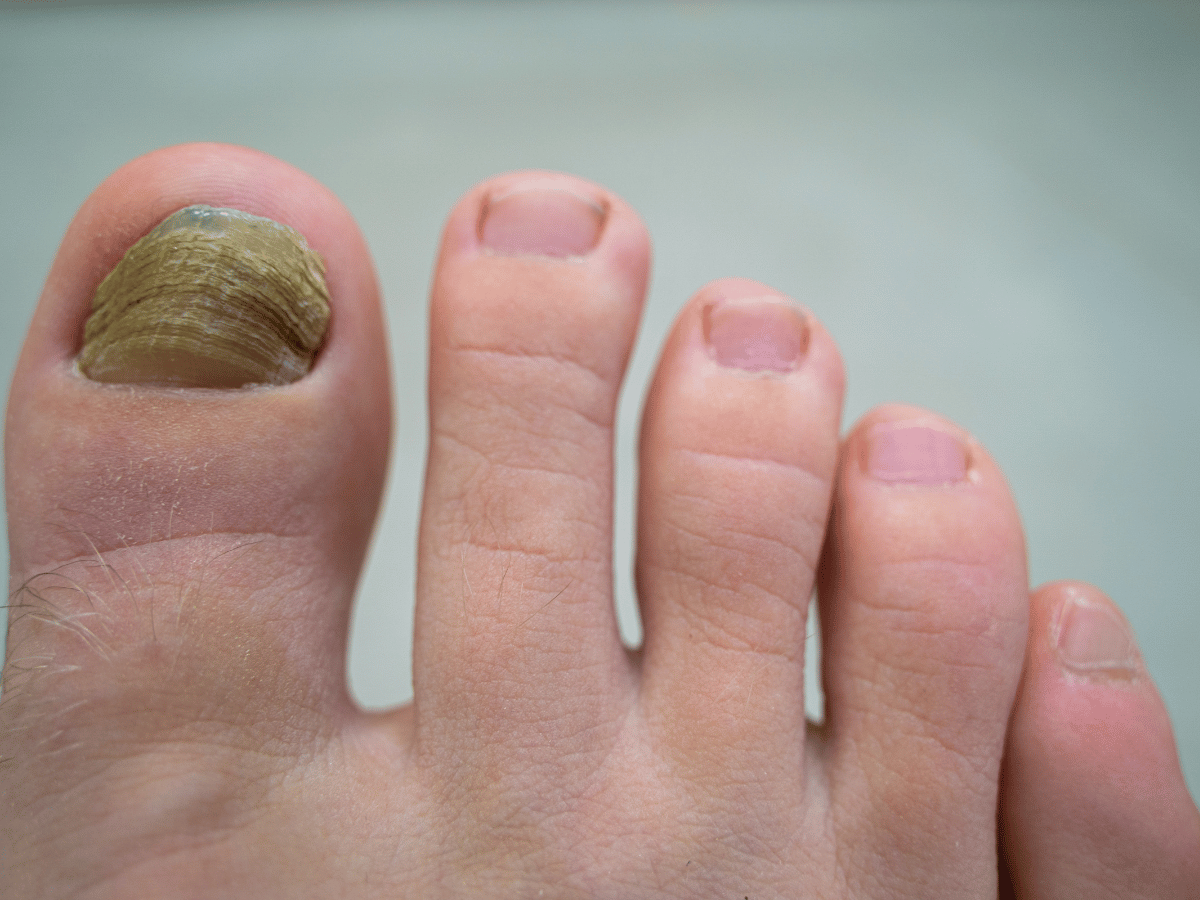
Nail fungus, medically termed onychomycosis, is a persistent and often frustrating infection caused by fungal organisms infiltrating nail tissue. It’s more than just a cosmetic nuisance. This infection commonly leads to thickened, discolored nails that can be painful and difficult to manage if left untreated.
Despite being widespread, impacting up to 20% of adults at some point, it’s often overlooked until symptoms become severe. But early identification and proactive care make a real difference.
We see nail fungus more frequently in certain groups. Age is a significant factor, those over 60 are at greater risk due to slower nail growth and reduced circulation. People with diabetes, weakened immune systems, or peripheral vascular disease also have increased vulnerability.
Other everyday risk factors include:
It’s not just about exposure, our body’s ability to defend against fungal invaders also plays a vital role.
Dermatophytes (a type of fungus) are the usual suspects behind nail infections. But yeasts and molds can also cause nail fungus, especially in fingernails or when there is a history of trauma or prior infection.
The fungus thrives in warm, moist environments. That’s why wet shoes, sweaty socks, and poor nail hygiene become breeding grounds. Nail trauma, think of a stubbed toe or repetitive pressure from tight shoes, also opens a gateway for infection.
At the same time, poor blood flow or weakened immune defense means the body has a harder time fighting back, letting the infection linger, and worsen.
Understanding what to look for helps catch the problem early. Fungal nail infections often present with:
Early-stage symptoms may be subtle. One common pattern we see is a yellow streak under the nail or white spots that slowly spread. Being vigilant about small changes can prevent more invasive interventions down the line.
Diagnosing nail fungus isn’t just a visual check. Though appearance gives us clues, several other conditions like psoriasis, trauma, or eczema can mimic fungal nail changes. For an accurate diagnosis, we typically recommend:
These tests guide personalized treatment. Why does it matter? Because using the wrong type of antifungal medication may not work if we’re dealing with the wrong type of fungus, or none at all.
Treating nail fungus requires patience, it’s a slow-growing area and eradication takes time. But we have several effective treatments today:
These are applied directly to the nail and surrounding skin. They’re most effective in early or mild cases where the fungus hasn’t fully penetrated the nail bed. Common options include:
They must be used consistently for months and often work best when combined with mechanical debridement (filing the nail).
Oral treatments work from within, delivering medication through the bloodstream to reach the source. They’re commonly used for moderate to severe infections or when multiple nails are involved.
These medications may require liver monitoring but are more effective in achieving total resolution over time.
While clinical treatment is crucial, lifestyle choices play a pivotal role in both treatment and prevention. Here are some recommended strategies:
Some natural remedies (like tea tree oil or Vicks VapoRub) have shown mild results in early stages, but they should never replace evidence-based treatments.
There’s promising research on the horizon. Laser therapy, for instance, has gained traction, although it remains somewhat controversial due to varying success rates in studies. It uses focused light to destroy fungal cells beneath the nail.
Other innovations include:
These advancements aim to tackle the stubborn nature of nail fungus while improving patient comfort and compliance.
It’s easy to underestimate how much nails affect our daily lives. For many of us, walking becomes uncomfortable. For others, the embarrassment of wearing sandals or reaching out with discolored nails erodes confidence.
Chronic nail fungus can lead to avoidance behaviors, skipping social events or hiding feet constantly. Left untreated, toenail fungus can even spread to other nails or lead to secondary infections, particularly in diabetic patients.
That’s why early management isn’t just aesthetic, it protects your health holistically.
Healthy nails start with mindful habits. Here’s what we recommend:
If you’ve had an infection before, be extra cautious. Recurrent onychomycosis is quite common, and prevention is your first line of defense.
If you’re noticing changes in your nails, whether discoloration, thickening, or discomfort, don’t ignore the signs. Connect with us at South Florida Multispecialty Hospital. Our expert team can provide accurate diagnosis and effective treatment to restore your nail health and confidence.
Nail fungus is a common infection caused by organisms like dermatophytes, yeasts, or molds. It often develops when fungi enter the nail bed via small cuts or nail separations, especially when exposed to damp, warm environments.
Symptoms include yellow or white discoloration, thickening, brittle or crumbling nails, nail distortion, foul odor, and sometimes discomfort or pain.
Older adults, diabetics, those with weakened immune systems, people with circulatory problems, and anyone frequently exposed to moist environments like gyms or pools are at higher risk.
Diagnosis is confirmed through clinical examination and supported by KOH microscopy, fungal culture, or molecular tests (like PCR).
Topical antifungal agents, oral antifungal medications, and mechanical interventions are the mainstays. In severe or resistant cases, laser therapy or nail removal might be recommended.
Yes, complete cure is possible with proper treatment, but recurrence is also common—especially without good nail hygiene. Preventative measures are crucial for long-term success.
Basic hygiene practices—like keeping nails clean and dry, wearing breathable shoes, and avoiding barefoot walking in public—help significantly. Some natural remedies may offer mild relief but should not replace medical treatment.
Results vary. Oral medications may show visible improvement in 6–12 weeks, but full nail regrowth can take 6–12 months. Topical treatments often take longer to be effective.
Your well-being is our top priority. Reach out today to discover how our dedicated team can support your health journey.
Have questions or want to learn more? Use the form below to get started!
Connect with South Florida’s trusted multispecialty care team and take control of your health with compassion and convenience.
©2025 South Florida Multispecialty Medical Group. All Rights Reserved.